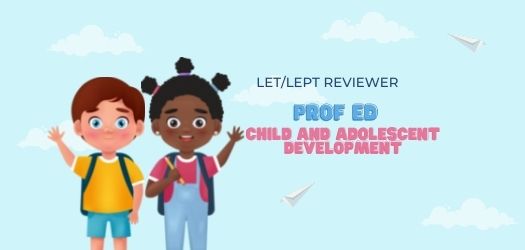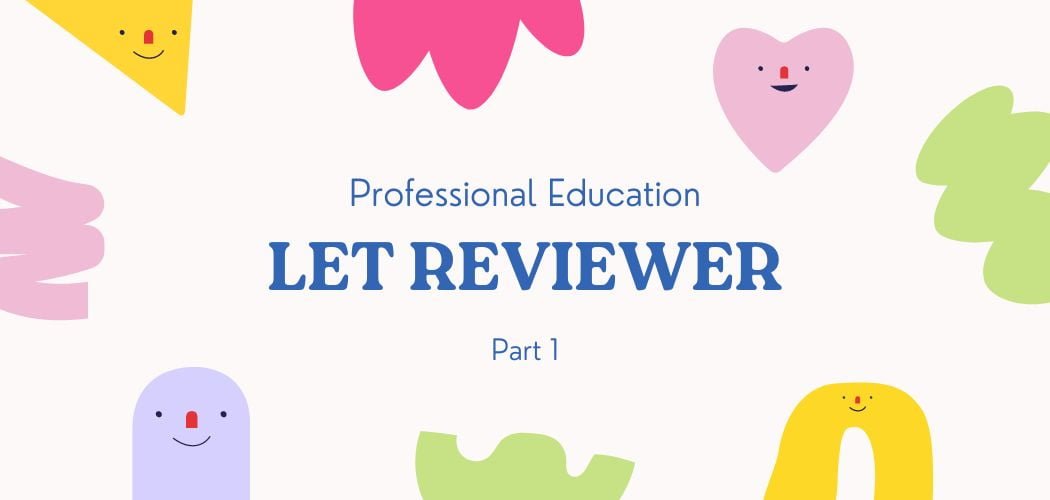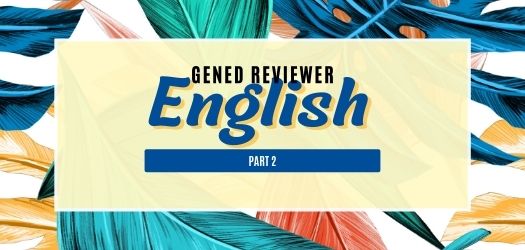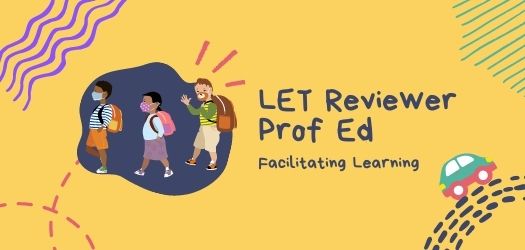Get a sense of what’s coming on your Professional Education (Prof Ed) exam with these 50 multiple-choice questions. This LET reviewer covers topics that are found in the Principles of Teaching subject.
Expect topics that may span from learning theories, teaching methods and strategies, classroom management, curriculum development, assessment and evaluation, diversity and inclusion, and education technology.
Recommended reading:
- 13 Tips From Repeaters: How to Pass the LET the First Time
- 5 Researched-Based Techniques to Pass the LET
- How to Remember Better: A Study Tip
Principles of Teaching Prof Ed LET reviewer
Note: The answer key can be found at the bottom of this page.
Question 1. To ensure the lesson will go smoothly, Teacher A listed down the steps she will undertake together with her students. What does this practice relate to?
A. Teaching style
B. Teaching method✅
C. Teaching strategy
D. Teaching technique
Question 2. The class of grade 6- Einstein is scheduled to perform an experiment on that day. However, the chemicals are insufficient. What method may then be used?
A. Project
B. Laboratory
C. Lecture
D. Demonstration✅
Question 3. Teacher C gives the class-specific topic as an assignment that they have to research and pass the following day. However, the students could not find any information about it. What method should Teacher C use to teach the assignment?
A. Project method
B. Discovery approach
C. Lecture method✅
D. Demonstration method
Question 4. Pictures, models, and the like arouse students’ interest in the day’s topic. in what part of the lesson should the given materials be presented?
A. Initiating activities✅
B. Culminating activities
C. Evaluation activities
D. Developmental activities
Question 5. In Bloom’s taxonomy of educational objectives, the domains are stated from the lowest to the highest level. Which of the following objectives belongs to the lowest level?
A. To identify the characters of the story✅
B. To differentiate active from passive voice
C. To give the available resources that could be recycled into useful things
D. To explain the procedure of changing improper fractions to mixed number
Question 6. The class of IV-Kalikasan is tasked to analyze the present population of the different cities and municipalities of the National Capital Region for the last five years. How can they best present their analysis?
A. By means of a table
B. By looking for a pattern
C. By means of graph✅
D. By guessing and checking
Question 7. There are several reasons why problem-solving is taught in Math. Which is the LEAST important?
A. It is the main goal for the study of Math✅
B. It provides the context in which concepts and skills are learned and applied
C. It provides an opportunity to develop critical and analytical thinking
D. It provides pupils an opportunity to relate Math to the real world
Question 8. Teacher D teaches in a remote high school where newspapers are delivered irregularly. knowing the importance of keeping the students aware of current affairs, what is probably the best way to keep the students updated?
A. Gather back issues of the newspaper and let students compile them.
B. Urge the students to listen to stories circulating in the community
C. Encourage the students to listen to daily broadcasts from a transistor radio.✅
D. The teacher should try all available means to get the newspaper delivered to the school.
Question 9. Devices can make a lecture more understandable and meaningful. What is the most important thing a teacher should consider in the selection and utilization of instructional materials?
A. Objectives of the lesson✅
B. Availability of the instructional materials
C. Attractiveness of instructional materials
D. Degree of interest on the part of the students
Question 10. Teacher E asks student A to identify and analyze events, ideas, or objects to state their similarities and differences. In which part of the lesson does the said activity take place?
A. Preparation
B. Generalization
C. Application
D. Comparison and Abstraction✅
Question 11. Which part of the lesson is involved in the giving of situations or activities based on the concepts learned?
A. Preparation
B. Generalization
C. Application✅
D. Comparison and Abstraction
Question 12. Teacher F wants the class to find out the effect of heat on matter. Which method will help him accomplish his objective?
A. Project method
B. Laboratory method✅
C. Problem method
D. Expository method
Question 13. In Math, Teacher G presents various examples of plane figures to her class. afterward, she asks the students to define each. What method did she use?
A. Inductive✅
B. laboratory
C. Deductive
D. Expository
Question 14. Teaching Tinikling to I-Maliksi becomes possible through the use of?
A. Inductive method
B. Expository
C. Demonstration method✅
D. laboratory method
Question 15. What is the implication of using the method that focuses on the “why” rather than “how”?
A. There is the best method
B. Typical one will be good for any subject
C. This method should be standardized for different subjects
D. Teaching methods should favor inquiry and problem-solving.✅
Question 16. When using a problem-solving method, the teacher can?
A. Set up the problem
B. Test the conclusion
C. Propose ways of obtaining the needed data
D. Help the learners define what is to be solved✅
Question 17. Which of the following characterizes a well-motivated lesson?
A. The class is quiet.
B. The children have something to do.
C. The teacher can leave the pupils.
D. There are varied procedures and activities undertaken by the pupils.✅
Question 18. Learners must be developed not only in the cognitive and psychomotor but also in the affective aspect. Why is the development of the latter also important?
A. It helps them develop a sound value system✅
B. Their actions are dominated by their feelings
C. It helps them to develop an adequate knowledge of good actions
D. Awareness of the consequences of their action is sharpened
Question 19. Which of the following attributes characterizes a learner who is yet to develop the concept?
A. The learner can identify the attributes of the concept.✅
B. The learner can summarize the ideas shared about the concept.
C. The learner can distinguish examples from non-examples.
D. The learners get a failing grade on the tests given after the concept has been discussed.
Question 20. The strategy which makes use of the old concept of “each-one-teach-one” of the sixty’s is similar to?
A. Peer learning
B. Independent learning
C. Partner learning
D. Cooperative learning✅
Question 21. Which part of the lesson does the learner give a synthesis of the things learned?
A. Motivation
B. Application
C. evaluation✅
D. Generalization
Question 22. Educational objectives are arranged from simple to complex. Why is this?
A. Each level is built upon and assumes the acquisition of skills from the previous level.✅
B. Objectives are broad and value-laden statements that lead to the philosophy of education.
C. Be idealistic and ambitious to begin, with a grandiose scheme for using taxonomy at all levels.
D. These are guidelines to be taught and learned where teachers and students evaluate learning.
Question 23. Which of the following is NOT true?
A. Lesson plan should be in a constant state of revision.
B. A good daily lesson plan ensures a better discussion.
C. Students should never see a teacher using a lesson plan.✅
D. All teachers regardless of their experience should have a daily lesson plan.
Question 24. In Music, Teacher 1 wants to teach the class how to play the piano in the Key of C. Which of the following should be his objective?
A. To play the piano in the key of C chords✅
B. To improve playing the piano in the key of C
C. To interpret the property of chords of the Key of C in the piano
D. To exhibit excellence in playing of piano in the key of C
Question 25. When using instructional material, what should the teacher primarily consider?
A. The material must be new and skillfully made
B. It must be suited to the lesson objective✅
C. The material must stimulate and maintain students’ interest
D. It must be updated and relevant to the Filipino setting.
Question 26. Teacher A wishes to write a lesson plan. Which question should she ask herself first?
A. What materials do I need?
B. How will I get things started?
C. What do I want to accomplish?✅
D. What exercise will I give my students?
Question 27. Which of the following characterizes best an effective classroom manager? One who is friendly yet?
A. Rigid
B. Demanding
C. Business-like✅
D. Buddy-buddy
Question 28. Which of the classroom activities below is effective?
A. The concept learned is applicable to daily life✅
B. The techniques and approaches used are varied
C. The variety of instructional materials used is evident
D. The laughter and enjoyment of students are contagious
Question 29. When is praise effective? When it ____.
A. describes students’ present accomplishment
B. shows spontaneity, variety, and other signs of credibility
C. focuses student’s attention on their own task-relevant behavior
D. provides information to students about their competence and the value of their accomplishments✅
Question 30. Which of the following is a divergent question?
A. How is water purified?✅
B. What are the parts of a sentence
C. What is the most populated country in Asia?
D. What is the formula for getting the weight of an object?
Question 31. Which of the following reading skill belongs to a higher level?
A. Drawing conclusion✅
B. Stating the main idea
C. Following directions
D. Noting specific details
Question 32. Which of the following questions is classified as low-level?
A. What is Science?✅
B. How is a city differentiated from a province?
C. If given a chance to become a government official, what reform/s will you advocate? Why?
D. Who among the Filipino heroes and heroines do you like best? Explain.
Question 33. Why does the teacher have to plan the day’s activities?
A. This is expected by pupils
B. This is required for a teacher
C. The ability of a teacher is tested
D. The accomplishment of the objectives is dependent on the plan✅
Question 34. Which of the following should the teacher use to start the class discussion?
A. Narrow question
B. Convergent question
C. Memory question
D. Divergent question✅
Question 35. Which of the following characterizes best a well-managed class? When learners
A. are controlled by the teacher
B. blindly obeys teachers’ instruction
C. pursue their task without inhibition
D. are engaged in an activity that leads them to realize the set goal✅
Question 36. Which of the following belongs to lower-order thinking skills?
A. Teaching for meaning
B. Encouraging creativity
C. Asking convergent questions✅
D. Making the students aware of their mental process
Question 37. When should Teacher M undertake the task of setting up routine activities?
A. Every homeroom period
B. On the very first day of school✅
C. Every day at the start of the session
D. As soon as the students have adjusted to their schedule
Question 38. Which of the following marks a conducive classroom?
A. Excessive praise
B. Individual competition
C. Long assignments
D. Cooperative learning✅
Question 39. Which of the following develops critical thinking?
A. Asking low-level questions
B. Blind obedience to authority
C. Asking convergent questions
D. Willingness to suspend judgment until sufficient evidence is presented✅
Question 40. Teacher N wants to develop the comprehension skills of his pupil. How should his questioning proceed?
I. literal
II. interpretation
III. Critical
IV. Integration
A. I, II, III, IV✅
B. I, III, II, IV
C. I, II, IV, III
D. IV, III, II, I
Question 41. Which of the following counters the teacher’s role as a facilitator of learning?
A. Does more talk than learners✅
B. Does less talk compared to learners
C. Makes use of interactive teaching strategies
D. Caters to multiple intelligence in the classroom
Question 42. Which of the following practices violates the guidelines in asking questions?
A. Avoid cognitive memory questions
B. Call on pupils before asking questions✅
C. Use probing questions to follow up on incomplete answers
D. Sequence questions so that higher-level questions build on the answers to the lower level
Question 43. Which of the following shows cooperation?
A. Doing all the work alone
B. Letting others copy from you
C. Collaborating with others in the group✅
D. Allowing others to dominate in the decision-making
Question 44. Which of the following violates good discipline?
A. Practice
B. Attention
C. Modeling
D. Punishment✅
Question 45. Asking a series of questions to a student is a violation of which technique in questioning?
A. Wait time✅
B. Prompting questions
C. Redirection
D. Probing questions
Question 46. Which of the following should Teacher O practice more if he wants to give his students the opportunity to think critically?
A. Provide questions with clues
B. Give questions that require analysis✅
C. Give questions that deviate from the main topic
D. Allow the children to ask questions during class discussion
Question 47. Which guideline in asking questions must Teacher P use to develop reflective thought and critical thinking among her learners?
A. Probing✅
B. Prompting
C. Wait time
D. Redirection
Question 48. Which of the following practices is an effective way to start a lesson?
A. Checking the attendance
B. Scolding someone who was late
C. Evaluating the work done the previous day✅
D. Reminding the pupils of the standards of listening
Question 49. Which of the following routines is the best way to start a class?
A. Ringing a bell
B. Greeting each other✅
C. Making the children line up
D. Asking the children to clean the room
Question 50. What is the most effective way to distribute papers/materials in class?
A. Give pupils papers one by one
B. Let the pupils come to the teacher one by one
C. Ask a leader pupil to distribute the papers
D. Instruct pupils to “Get one and pass”.✅
Other Prof Ed Reviewers
| Prof Ed Reviewer | No. of Items |
|---|---|
| Prof Ed LET Reviewer: Part 1 | 50 items |
| Prof Ed LET Reviewer: Part 2 | 50 items |
| Prof Ed LET Reviewer: Part 3 | 50 items |
| Child and Adolescent Development | 50 items |
| Facilitating Learning | 50 items |
| Curriculum Development | 50 items |
| Teaching Profession | 50 items |
| Educational Technology | 50 items |
| Social Dimensions | 50 items |
| Assessment of Learning | 50 items |



